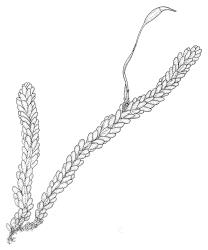Dichelodontium is a monotypic genus endemic to N.Z. The species description applies to the genus.
Dichelodontium is retained in the Ptychomniaceae on the strength of the cladistic trees of Bell et al. (2007) and its placement here by Goffinet et al. (2009).
Magill (1987) discussed at length the nature of the Dichelodontium peristome and concluded it is endostomal in nature; he advocated the retention of this monotypic genus in the Ptychomniaceae on the basis of its peristome structure. Citing Magill, Allen (1999) proposed the transfer of Dichelodontium to the Lepyrodontaceae, noting the endostomal nature of the peristome, linear to sub-vermicular laminal cells, poorly differentiated alar cells, weak costae, sheathing perichaetia, cucullate calyptrae, and the presence of rhizoid initials in the axils and around branch buds. However, because of the findings of Bell et al. (2007), Allen’s proposed transfer is not followed here.
| Category | Number |
|---|---|
| Indigenous (Endemic) | 1 |
| Total | 1 |




